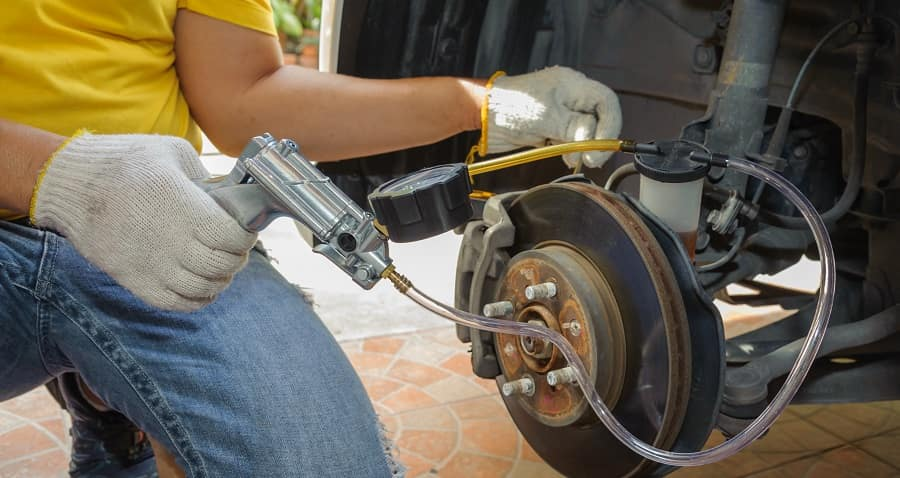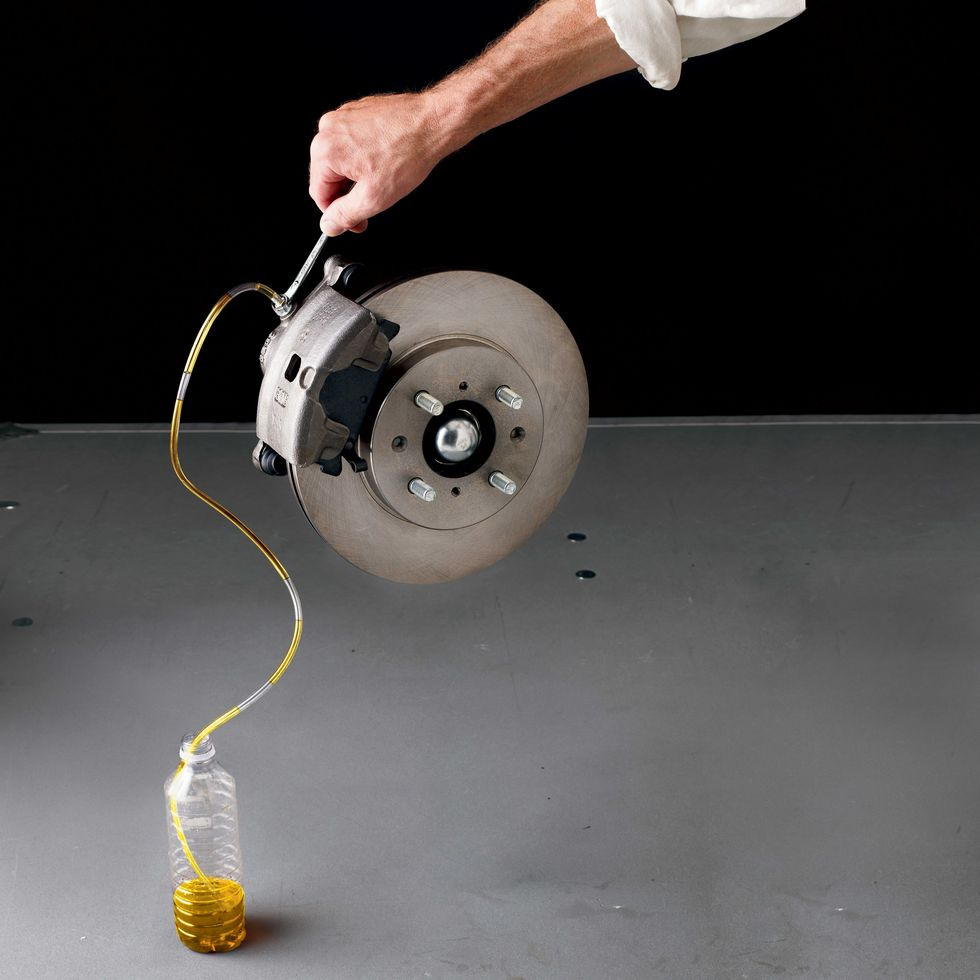Getting the brake to bleed properly has a lot to do with the car mechanics. And a good portion of that depends on the size of the brake tube.
What size tube for brake bleeding should you go for?
For most cases, you can use ⅜ ID X ¼ ID and 5/16 OD X 3/16 ID tubes. This measurement can vary from type to type. You can also custom measure the bleeder screw size and buy a tube accordingly. Properly bleeding the brakes is very important as well.
Awkward compatibility won’t make the brakes bleed properly, trapping the air bubbles inside. Not looking forward to having less efficient brakes due to greatly reduced hydraulic pressure? Then this is just what you need!
Carefully read the entire piece for more insight on this topic.
What Factors Alter the Size of the Tubing?
There aren’t any universal sizes for brake bleeders. The brake bleeder tube sizes can vary on a number of factors. I’ve mentioned some of them below, check them out!
Type of Vehicle:
This is the most obvious factor of them all. The type of your vehicle will surely affect the tube sizing. The wheel count, engine type, etc change the tube sizes here!
For instance, a car is different from a motorcycle. Accordingly, the motorcycle brake bleed tube size will be different from the car.
Bleeder Screw Size:
Bleeder screw sizes directly affect the brake bleeding tube size. Since the bleeder tube will be surrounding the bleeder screw, it’s important that the tube fits.
Wheel Size:
Wheel size is often overlooked the most. The wheel size changes the position of the brake bleeder screw, which is essential.
Not all wheel sizes are the same; that way, the tube size changes for every wheel. For example, model 3-18 compared to 19 and 20 wheels will have different tube size.

What Size Tube for Brake Bleeding?
Using a tube while bleeding your brakes can make it a very easy task to pull off. But, you need to perfect sized tube to bleed your brakes.
So, what size tubing for brake bleeder do you need?
Most of the brake bleed screws are compatible with ¼” tubes. You can use ID vinyl tubes if you want. ⅜ ID X ¼ ID and 5/16 OD X 3/16 ID are also good fits. The advantage is, that you can stretch it by a bit and adjust it to your needs.
If these tubing sizes don’t fit, you measure the bleeder screw. Use a measuring tape for this. By using the measurement, you can buy a perfectly fitting tube of your choice!
Remember, these measurements are valid if you’re figuring out what size clear tube to bleed brakes. Whatever material the tube is built with, the size will remain the same.
When talking about materials, using clear tubes is the best idea here. That way, you can see through the tube and ensure that there are no air bubbles.
Colored tubes can add extra work; since you have to inspect the jar after every pump.
Since many calculations come in hand with the tube, some people don’t like it. That’s why they ask:
“Can you bleed brakes without a tube?”
The answer is— yes you can! You will need another method to catch the fluid. An inexpensive option can be paper cups. It’s also easy to control fluid using paper cups. However, using tubes is the most hassle-free and simple way when it comes to bleeding brakes.
The above discussion should clarify your confusion on what size pipe for brake bleeding you require!
Importance of Bleeding Brakes
Bleeding the brake is very important. If you want quick and responsive brakes for your vehicle, bleeding the brake is the way.
When you don’t bleed a brake, it can raise many issues. For instance, the brakes will need more time to respond, they’ll also get spongy. The car/motorcycle fitness will drop too; that demands a ticket on the streets!
Bleeding a brake is similar to lubricating your steering wheel. Unbled brakes get spongy; on the other hand, not lubricating can make the steering noisy once cold.
Now you know the importance of bleeding the brakes. But, how do you bleed brakes? Below, I’ve provided the steps to this procedure. Read to find out!
How to Bleed Brakes?
Along with the sizing of the tube, properly bleeding the brakes is necessary. There are many steps to this process, which should be maintained by a sequence.
Bleeding breaks may seem like a complex thing to do, but it’s easy. You will need another person; because It’s a 2-man job.
Follow the steps below to properly bleed your breaks.
- First, locate the nozzle. It should be at the back of your brakes. The nozzle is also known as the brake bleeder screw. Jacking up the vehicle for this task will make it easier.
- Then, loosen the screw using a wrench. It’s very important to use the right-sized wrench for this job.
Although you can use regular wrenches, there are special wrenches named “bleeder wrenches” for this job. You can use one of them to not shave the hex head off.
- By now you should know what size tube to bleed motorcycle brakes or car brakes. Use the appropriate size tube and stick it over the bleeder screw.
One end should be at the end of the bleeder screw. And the other end should be in a jar, where the brake fluid will be stored. Fill the jar with brake fluid.
Using good quality brake fluid is a must here. Using not just any brake fluid can get the task done. You should always go looking for quality brake fluids that are highly compatible with any kinds of brake.
We took the liberty to recommend some good quality brake fluids for you to pick from. Here, have a look:
| Product | Feature | Price |
| Prestone AS400 DOT 3 Synthetic Brake Fluid | Prevents Dangerous brake vapor50,000 mile extended life fluidPrevents overheating | Check Price |
| Bosch ESI6-32N Brake Fluid | High CompatibilityGood noise reductionAnti-wear and tear | Check Price |
| Heavy Duty Brake Fluid- Dot 3 | Prevents break failure from vapor lockHighly compatible | Check Price |
You can get the best braking performance and experience by using any of the fluids above. All the above mentioned brake fluids maintain government standard wet and dry boiling point, keeping you and your car safe.
- Tell the other person to pump the car/bike pedal. Have the person pump a few times. Pumping the brake pedal will create air pressure inside the vehicle.
That way, the air bubbles can pile up, and later you can extract the air bubbles. While they are holding the brake pedal down, open the bleeder screw.
Opening the bleeder screw will make the brake fluid squirt out in the jar. Tighten the bleeder screw while the pedal is down, and repeat the process.
You can get brake bleeding pump to do the task yourself. No need for a second pair of hands!
- Keep repeating the process until you see zero air bubbles coming out with the brake fluid. The process will get shorter each time, so don’t worry about the time.
- Finally, fill up the master cylinder with bubble-free brake fluid. Whenever you start or end brake bleeding, filling up this compartment is very crucial.

And that’s about it. This is how you properly bleed the brakes on your vehicle! Note that, if you use a brake bleeding tool, you can bleed the brakes on your own.
Frequently Asked Questions (FAQs)
Should You Check Brake Fluid While the Engine Is Hot or Cold?
Checking the brake fluid level when the engine is cold is a good idea. When the engine is hot, the fluid might have a reaction to it. This is applicable to any fluid. If you’re going to check or work on something, cool off your engine first. Additionally, the checking should be done on a leveled ground.
What Color Should Brake Fluid be?
Brake fluids should have a yellow tint to them. It’s considered a healthy color for brake fluids. Anything other than that might indicate problems. Any dark tint of the brake fluid needs changing asap. Light colors mean that the fluid is alright. But too light tint is also considered to be risky.
Can You Mix Regular Brake Fluid with Synthetic?
No, mixing regular brake fluid with synthetic brake fluid is a bad idea. The DOT rating should not be changed or interfered with. Mixing silicon and glycol-based fluids is very risky, to be exact. However, It’s possible to mix different brake fluids containing the same type/DOT rating.
The Final Words
This is the end of this article. Hopefully, now you know what size tube for brake bleeding you need.
It’s understandable if you don’t want to bleed the brakes on your own. Feel free to take help from a car mechanic; if that is the case!
All the best!
- Is The Jeep Cherokee Frame or Unibody (Briefly Answered) - November 10, 2022
- Are Titan Wheel Spacers Good (The 360 Guidelines) - November 9, 2022
- FCW off Jeep (Is It Important for Your Car) - November 9, 2022

